Matt Gorbett
Tiled Bit Networks: Sub-Bit Neural Network Compression Through Reuse of Learnable Binary Vectors
Jul 16, 2024Abstract:Binary Neural Networks (BNNs) enable efficient deep learning by saving on storage and computational costs. However, as the size of neural networks continues to grow, meeting computational requirements remains a challenge. In this work, we propose a new form of quantization to tile neural network layers with sequences of bits to achieve sub-bit compression of binary-weighted neural networks. The method learns binary vectors (i.e. tiles) to populate each layer of a model via aggregation and reshaping operations. During inference, the method reuses a single tile per layer to represent the full tensor. We employ the approach to both fully-connected and convolutional layers, which make up the breadth of space in most neural architectures. Empirically, the approach achieves near fullprecision performance on a diverse range of architectures (CNNs, Transformers, MLPs) and tasks (classification, segmentation, and time series forecasting) with up to an 8x reduction in size compared to binary-weighted models. We provide two implementations for Tiled Bit Networks: 1) we deploy the model to a microcontroller to assess its feasibility in resource-constrained environments, and 2) a GPU-compatible inference kernel to facilitate the reuse of a single tile per layer in memory.
Cross-Silo Federated Learning Across Divergent Domains with Iterative Parameter Alignment
Nov 14, 2023Abstract:Learning from the collective knowledge of data dispersed across private sources can provide neural networks with enhanced generalization capabilities. Federated learning, a method for collaboratively training a machine learning model across remote clients, achieves this by combining client models via the orchestration of a central server. However, current approaches face two critical limitations: i) they struggle to converge when client domains are sufficiently different, and ii) current aggregation techniques produce an identical global model for each client. In this work, we address these issues by reformulating the typical federated learning setup: rather than learning a single global model, we learn N models each optimized for a common objective. To achieve this, we apply a weighted distance minimization to model parameters shared in a peer-to-peer topology. The resulting framework, Iterative Parameter Alignment, applies naturally to the cross-silo setting, and has the following properties: (i) a unique solution for each participant, with the option to globally converge each model in the federation, and (ii) an optional early-stopping mechanism to elicit fairness among peers in collaborative learning settings. These characteristics jointly provide a flexible new framework for iteratively learning from peer models trained on disparate datasets. We find that the technique achieves competitive results on a variety of data partitions compared to state-of-the-art approaches. Further, we show that the method is robust to divergent domains (i.e. disjoint classes across peers) where existing approaches struggle.
Sparse Binary Transformers for Multivariate Time Series Modeling
Aug 09, 2023Abstract:Compressed Neural Networks have the potential to enable deep learning across new applications and smaller computational environments. However, understanding the range of learning tasks in which such models can succeed is not well studied. In this work, we apply sparse and binary-weighted Transformers to multivariate time series problems, showing that the lightweight models achieve accuracy comparable to that of dense floating-point Transformers of the same structure. Our model achieves favorable results across three time series learning tasks: classification, anomaly detection, and single-step forecasting. Additionally, to reduce the computational complexity of the attention mechanism, we apply two modifications, which show little to no decline in model performance: 1) in the classification task, we apply a fixed mask to the query, key, and value activations, and 2) for forecasting and anomaly detection, which rely on predicting outputs at a single point in time, we propose an attention mask to allow computation only at the current time step. Together, each compression technique and attention modification substantially reduces the number of non-zero operations necessary in the Transformer. We measure the computational savings of our approach over a range of metrics including parameter count, bit size, and floating point operation (FLOPs) count, showing up to a 53x reduction in storage size and up to 10.5x reduction in FLOPs.
Randomly Initialized Subnetworks with Iterative Weight Recycling
Mar 28, 2023
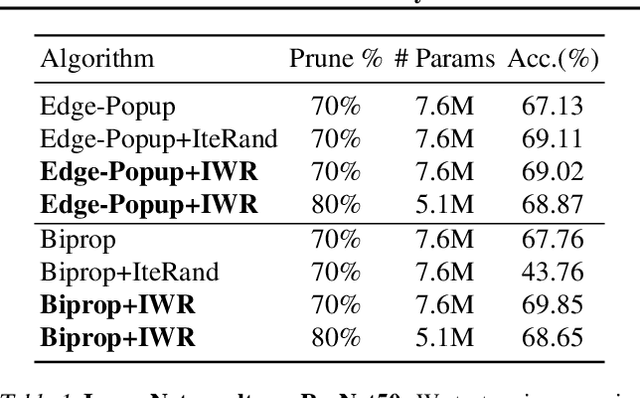

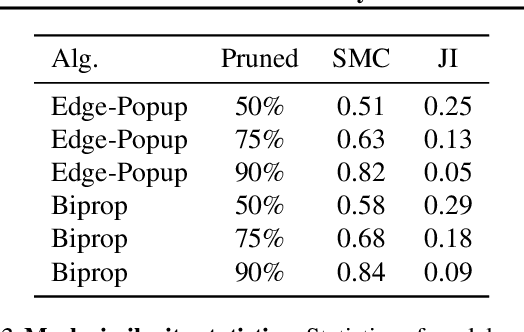
Abstract:The Multi-Prize Lottery Ticket Hypothesis posits that randomly initialized neural networks contain several subnetworks that achieve comparable accuracy to fully trained models of the same architecture. However, current methods require that the network is sufficiently overparameterized. In this work, we propose a modification to two state-of-the-art algorithms (Edge-Popup and Biprop) that finds high-accuracy subnetworks with no additional storage cost or scaling. The algorithm, Iterative Weight Recycling, identifies subsets of important weights within a randomly initialized network for intra-layer reuse. Empirically we show improvements on smaller network architectures and higher prune rates, finding that model sparsity can be increased through the "recycling" of existing weights. In addition to Iterative Weight Recycling, we complement the Multi-Prize Lottery Ticket Hypothesis with a reciprocal finding: high-accuracy, randomly initialized subnetwork's produce diverse masks, despite being generated with the same hyperparameter's and pruning strategy. We explore the landscapes of these masks, which show high variability.
Utilizing Network Properties to Detect Erroneous Inputs
Feb 28, 2020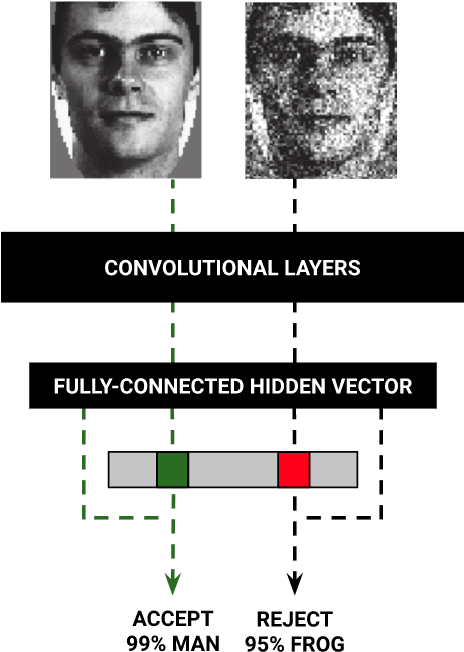
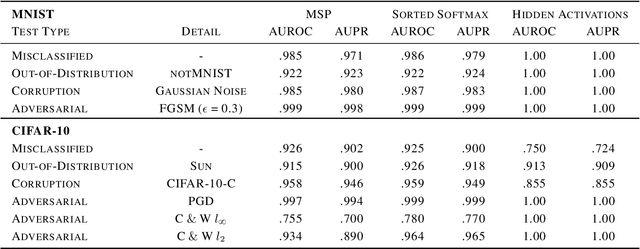
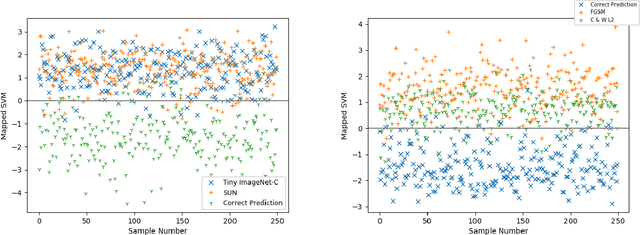
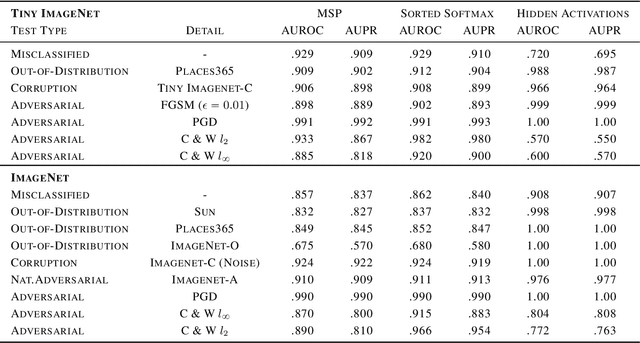
Abstract:Neural networks are vulnerable to a wide range of erroneous inputs such as adversarial, corrupted, out-of-distribution, and misclassified examples. In this work, we train a linear SVM classifier to detect these four types of erroneous data using hidden and softmax feature vectors of pre-trained neural networks. Our results indicate that these faulty data types generally exhibit linearly separable activation properties from correct examples, giving us the ability to reject bad inputs with no extra training or overhead. We experimentally validate our findings across a diverse range of datasets, domains, pre-trained models, and adversarial attacks.
 Add to Chrome
Add to Chrome Add to Firefox
Add to Firefox Add to Edge
Add to Edge